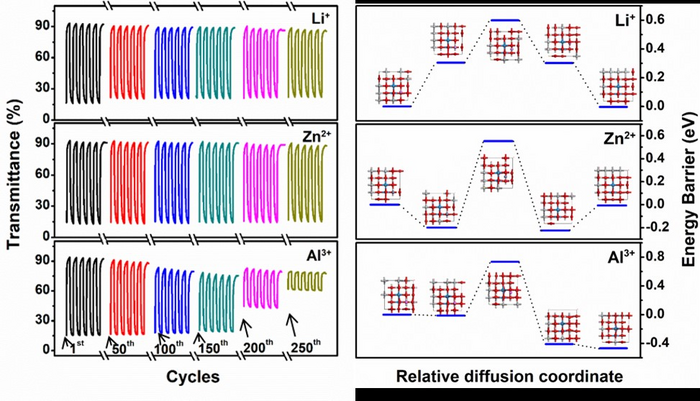They published their work on Aug. 3rd in Energy Material Advances.

Credit: Yi Liang, Guangxi University
They published their work on Aug. 3rd in Energy Material Advances.
“It is of great significance to search for alternative cheap, stable, and rapid insertion ions in EC devices to achieve cost-effective and rapid EC application.” said corresponding author Sheng Cao, associate professor with the School of Physical Science and Engineering Technology, Guangxi University. “Currently, there are many EC materials with Li+ and H+ as electrolytes, but they still have some problems, which hinder the further development.”
Cao explained that multivalent ions as insertion ion electrolytes can significantly improve the EC performance because the number of electrons per multivalent metal ion intercalates into the framework than Li+ or other monovalent ions.
“Zn2+ is regarded as superior to others to trigger the electrochromism due to its simplified preparation process and nontoxicity,” Cao said. “Furthermore, the EC device of trivalent Al3+ ion intercalation has attracted extensive attention because of its rich crustal storage, small ion radius, high optical contrast, safety, and reliability.
However, due to the strong electrostatic interaction between multivalent ions and the intercalation framework, there are great difficulties in the intercalation process. According to Cao, so far, the reports on EC performance driven by different valence cation ions mainly focus on the classical tungsten oxide EC materials, and there is a lack of systematic research on other EC materials. Titanium dioxide (TiO2) is a great potential candidate material because of its excellent physical, chemical stability, and acid resistance. However, there is still no report regarding TiO2 for trivalent ions electrochemical cells from the EC community or systematic research on EC performance driven by different valence ions yet.
The challenge is the stronger Coulomb ion lattice interaction of multivalent ions than monovalent ions, Cao said that tungsten doping into TiO2 can reduce the intercalation energy of ions and activate its electrochromic properties. Cao and his team explore the EC properties of anatase W-doped TiO2 NCs in different valence cations (i.e. Li+, Zn2+, and Al3+) by in-situ transmission spectroscopy and electrochemical tests.
“Experimental results and theoretical calculations show that Zn2+ can bring the required fast switching, high contrast, and high stability for EC devices,” Cao said. “The research results are of great significance to the basic research in the field of electrochromism and open up a new direction for realizing long-term stable, durable, and fast-switching devices.”
Cao is also affiliated with the Guangxi Key Laboratory of Processing for Non-ferrous Metals and Featured Materials. Other contributors include Yi Liang, Yuwei Liu, Lijuan He, Xinxin Han, Ruosheng Zeng, Jialong Zhao and Bingsuo Zou, the MOE Key Laboratory of New Processing Technology for Non-ferrous Metals and Materials, Guangxi University.
The National Natural Science Foundation of China (51902064), the Scientific and Technological Bases and Talents of Guangxi (Guike AD20159073), Guangxi Natural Science Foundation (2022GXNSFFA0350325), the “Guangxi Hundred-Talent Program”, and the special fund for “Guangxi Bagui Scholars” supported this work.
###
Reference
Authors: Yi Liang,1 Sheng Cao,1 Yuwei Liu,1 Lijuan He,1 Xinxin Han,1 Ruosheng Zeng,1 Jialong Zhao,1 and Bingsuo Zou1
Title of original paper: Unraveling the Effect of Cation Types on Electrochromic Properties of Titanium Dioxide Nanocrystals
Journal: Energy Material Advances
DOI: 10.34133/2022/9878957
Affiliations:
1MOE Key Laboratory of New Processing Technology for Non-Ferrous Metals and Materials, And Guangxi Key Laboratory of Processing for Non-Ferrous Metals and Featured Materials, School of Physical Science and Technology, Guangxi University, Nanning 530004, China
About the author:
Sheng Cao received his Ph.D. degree from the University of Science and Technology Beijing. Then he served as a research fellow at the National University of Singapore. After that, he joined Guangxi University as an associate professor at the MOE Key Laboratory of New Processing Technology for Non-ferrous Metals and Materials, and the School of Physical Science and Engineering Technology. His research interests involve quantum dot light-emitting diodes and electrochromic smart windows.
Journal
Energy Material Advances
DOI
10.34133/2022/9878957
Method of Research
Experimental study
Subject of Research
Not applicable
Article Title
Unraveling the Effect of Cation Types on Electrochromic Properties of Titanium Dioxide Nanocrystals
Article Publication Date
3-Aug-2022
COI Statement
The authors declare no conflict of interest.




